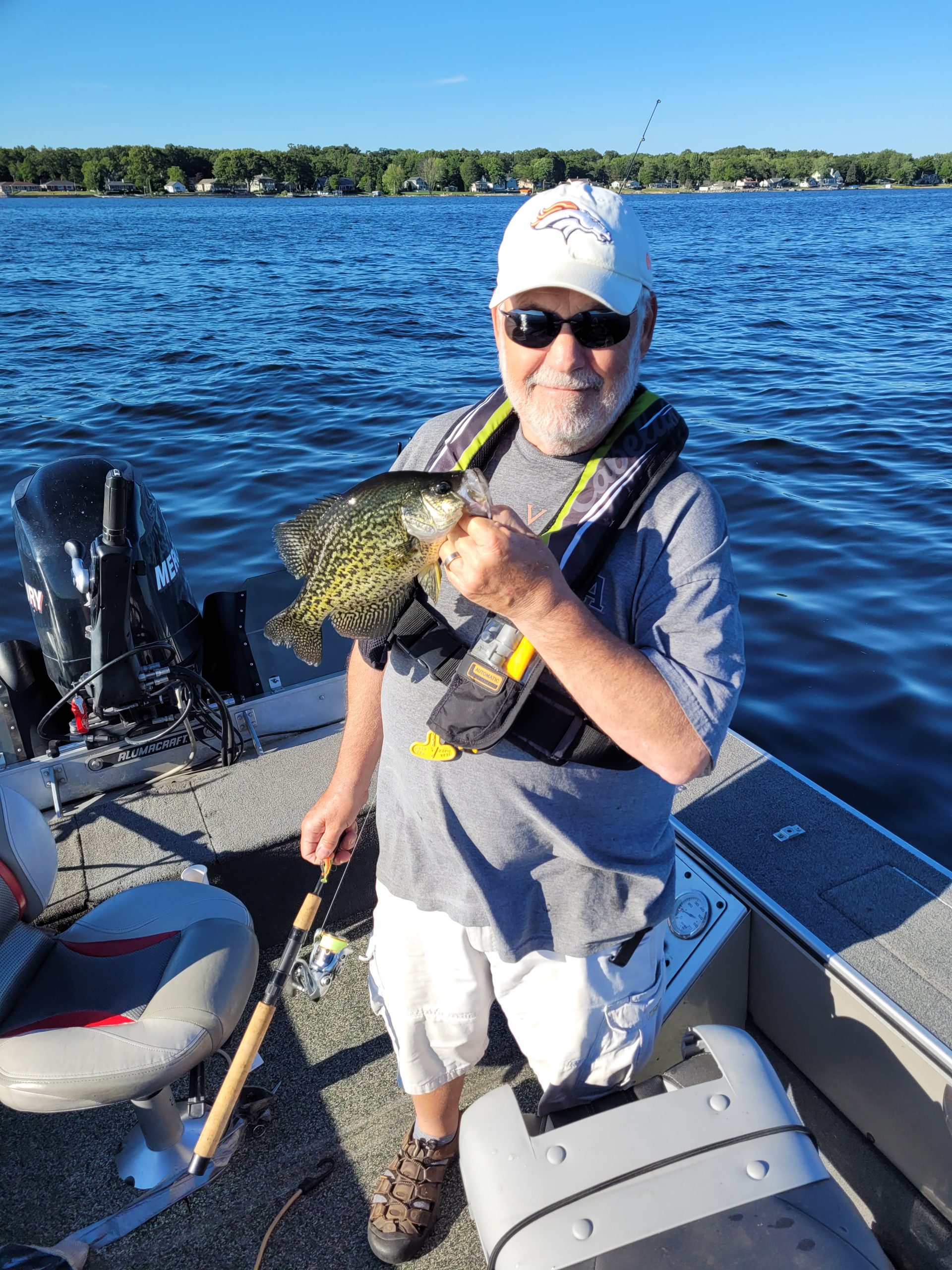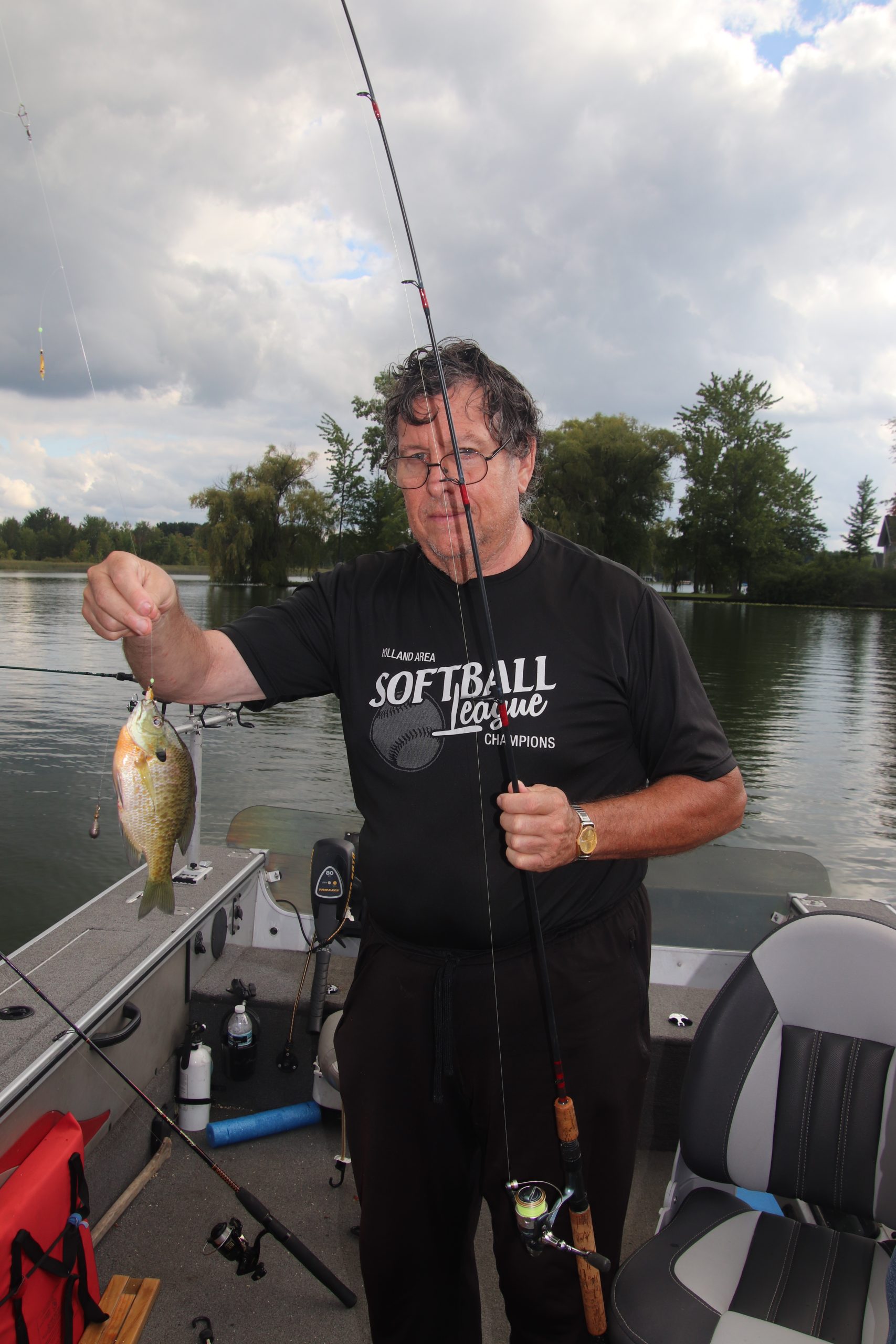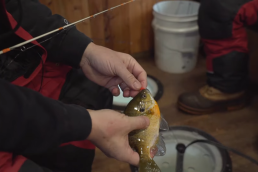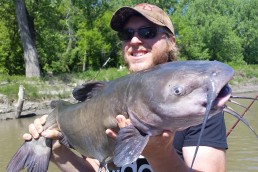Catching Panfish After the Spawn
SHARE THIS POST
Fishing panfish spawning beds is a time-honored event. Anglers line up along a shoreline, picking bluegills off beds. Sight fishing offers loads of fun. But after the spawn is truly my favorite time to catch them.
One the spawn is over, most anglers’ success rate falls. If they would learn to get away from the shoreline, their success rates would improve. As post-spawn bluegills in natural lakes retreat from the shoreline, they move to the area near or along the deep weed line.
If your lake is home to cabbage weeds, then look no further. Bluegills will camp out much of the summer along a cabbage weed line. In early summer, ‘gills can be found nearly any place along the weeds. As the heat beats down, ‘gills often move to the deepest edges of the weeds.
If you have the opportunity to snorkel, check out the deep cabbage weeds. You will find open pockets in the weed edge and pathways along the bottom where big bluegills can simultaneously hide from the bright sun and predators. These large weed patches are bait factories. Plenty of forage can be found in a typical weed patch.
When we fish the weeds, we most often use a Carlisle Slip float on one rod and cast with the other rod. Our slip bobber rig will have either a Hot Legs rubber spider or a Moon Glitter Teardrop tipped with a waxworm. Our casting rods might have a Charlie Brewer 1-inch panfish grub or a mini worm harness, much like a ‘crawler harness rigs, only smaller, rigged with a Belgium worm.

The barely-1-inch Brewer Grub dances and dazzles in the water, driving bluegills crazy. Think of the bluegill buster as a miniature ‘crawler harness rig. It’s’ much like a ‘crawler harness designed for worms. Belgium worms are larger than a standard worm and stay on the hook better.
Most ‘gills will be caught where a small opening is found. These openings could be the size of a kitchen table or a small bedroom. A pair of polarized sunglasses greatly assists in spotting the openings and changes in the weed patch.
Any drop-off that borders or comes close to a weed patch may hold ‘gills. Note the wind direction. We enjoy fishing deeper water that has wind blowing across a weed flat, into the deep water. Plankton and small insects get pushed out of the weeds into the bordering deep water.
Moving into summer, ‘gills will hover just above the thermocline. On many lakes, this might be somewhere between 18 and 22 feet deep.
During the dog days of summer, somewhere around the middle of July, bluegills will suspend over the deeper basins of a lake. These schools will jump right out on your graph. The key is fishing at the exact level of the fish shown on the graph.
We use both standard 2-D sonar and side scanning so to search out schools of ‘gills. When we find a school, we throw out a marker buoy and quickly look for a second pod of fish. If we can find two schools, the better for us.
Side scan will pinpoint schools of fish 8 feet on each side of the boat. When we spot a school, we drag a waypoint over the school. If anglers would just spend some time learning how to use side scan, their summer panfishing success would soar.
Summertime crappie fishing becomes a feast or famine situation. Once you find the crappies, the catching can be fast and furious. The problem lies in finding the fish, which is about 60 percent of the game.
Certain areas hold more crappies than other locations. Crappies like green weeds, shade and minnows. Therefore, start your search along the weeds. Before wetting a line, verify that the crappies are there.
Side scan is available on most graphs and will reveal pods of fish. The same is true with forward sonar. When we fish the weeds, we turn up the gain or sensitivity on our graphs.
Cruise along a weed line staying 30 to 50 feet outside it. With the gain turned, up you will spot open pockets in the weeds. You will also see the fish moving. We also search for schools of baitfish, which show up as a ball.
If nothing of interest is spotted, head out say 50 feet and side scan in two directions. Look outward 50 to 60 feet. You can also run at top speed using your 2-D sonar. Crappie schools show up clearly as you run over them.
Are you enjoying this post?
You can be among the first to get the latest info on where to go, what to use and how to use it!
Keep your eyes peeled for schools of baitfish being pushed upward by bigger fish feeding on them from below. You will see minnows or shad skipping across the surface. Whenever you see this, stop and start fishing.
Shade is another option. Cruise around areas with rafts, docks and boats that have not moved for a long period of time. Once again, look for actual pods of fish or balls of baitfish.
Once a likely spot is found, cast or slow troll until you find fish. Trolling works best when the pods of fish are small and scattered. Casting is best when the pod is tight and holding in a very set location.
There are two good trolling speeds. You can troll slowly—say around 1/2 mph. Or you can troll quickly, say 1 mile per hour or faster. We have trolled at speeds pushing 1.5 mph.
During the dog days of summer, go fast. You can and should move along quickly. Crappies will smack fast-moving bait. Watch the minnows and see how fast they move when spooked.
You can also quickly make a few turns of the reel handle and then pause. This method mimics a fleeing minnow that might be wounded. This is a fun way to catch crappies. Reel, stop and repeat. Most of the hits will occur at the pause mark.
Minnow-intimating crankbaits such as the Bandits, Salmo Hornets or Flicker Shads are perfect. Plastic tails and spinners are near the top of my list. Versatile plastics and spinners can be fished fast or slow, near the surface, halfway down or at the bottom.
When we troll, we often add drop-shot sinkers to the line a foot or two above the lures. Road Runner spinners and Charlie Brewer Slider Spin Jigs are perfect for summer.
We also use a lot of Brewer Original weedless crappie jig heads. Many times, we use two jig heads tied in tandem. This doubles your chance at success and eliminates the need for adding a sinker.
When trolling at fast speeds, use two 1/4-ounce jigheads. When casting, we usually opt for two 1/16-ounce heads. We use a 2-inch plastic tail when fishing a spinner. While the Brewer Crappie Grub is normally my favorite, when a want a fast-action bait, I grab their Crazy Tail Grubs.

A combination of chartreuse and yellow plastics suit 90 percent of our needs. Throw out the playbook as size is concerned. While 2-inch is standard, be brave and try a 3-inch tail during summer. Minnows are growing larger by this time of the year, and if shad are present in your body of water, match the hatch size-wise.
Fishing any type of wood cover is a good bet during summer. On reservoirs such as Hardy Pond or Croton Pond, anglers find plenty of wood structure. Some of this wood will be large oak or pine trees that tipped over and slid down the steep hillsides.
Stump fields on deep flats hold plenty of forage and attract schools of crappie. Using side scan and then down scan, the stump fields pop right out. On both of these waters, t’s not uncommon to see 100 to 200 fish on a single submerged, vertical tree.
Fishing any type of wood requires a vertical approach. This can be done via a long rod in the 14- to 16-foot range, or by using a slip float. A long rod is preferred when fishing a submerged vertical tree. You can reach out and work the tree without spooking the fish. Stumps and fallen trees can be worked in the same manner.
Trust your electronics and find these isolated honey holes. Get away from the shoreline and enjoy the best panfishing of the year.
MWO
SHARE THIS POST
Did you enjoy this post?
You can be among the first to get the latest info on where to go, what to use and how to use it!
Jack Payne
Jack Payne is an accomplished angler and hunter who enjoys teaching others as much as learning from others. Seminar speaker, outdoor photography enthusiast, hunter safety instructor and volunteer at many events for both kids and adults as an instructor.



